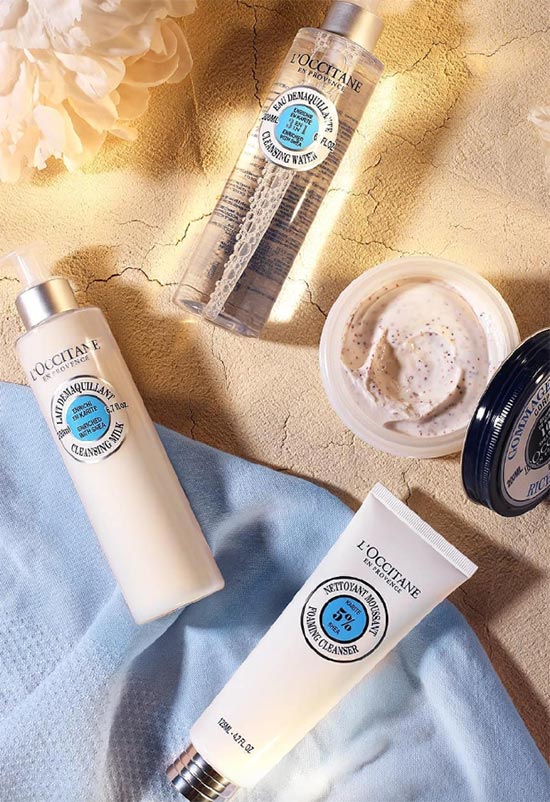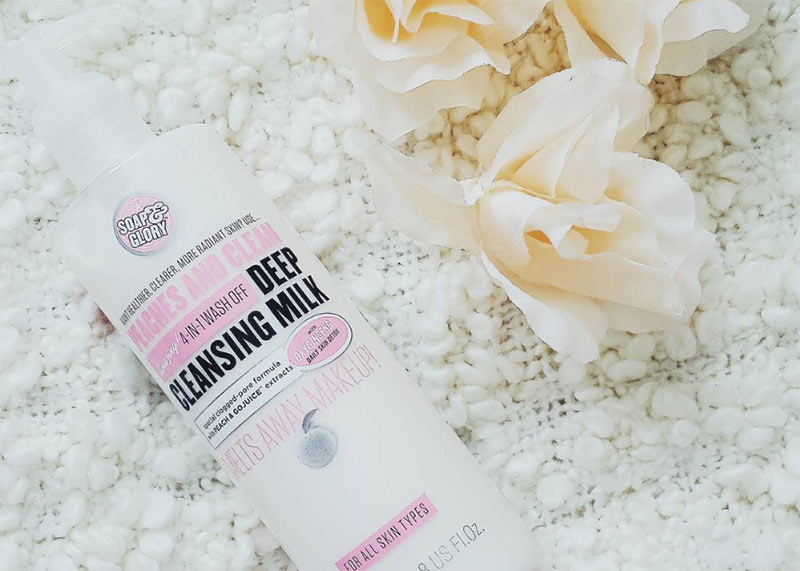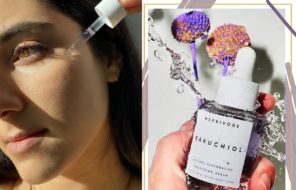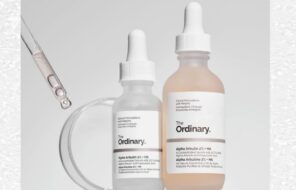A cleansing milk sits somewhere between a gel cleanser and an oil or balm cleanser, by helping to remove makeup thoroughly without drying out or irritating the skin. The milky texture is uniquely luxurious, so if you’re a fan of skincare routines that feel like self-care, definitely take milk cleansers into consideration.
Below, we explain exactly what cleansing milk is, how it works, and what the pros and cons are for using it, so you can figure out if cleansing milk is right for you. We also explain the best method for using cleansing milk to get your face feeling clean and healthy.
In this article:
What Is Cleansing Milk and How Is It Different from Other Facial Cleansers?
Cleansing milks are named this way because of their consistency. They usually have a creamy white color, while their texture is that of a very liquidy and runny cream.
Cleansing milk is a type of facial cleanser made of a blend of emollients and water that can break down makeup, dirt, sweat and oils. Milk cleansers can either be wiped off with a cloth or face wipe like makeup removers, or they can be rinsed away with water.
Unlike gel or foam facial cleansers, cleansing milks do not create a lather, nor do they foam up. The only reasons gel and powder cleansers lather up is because they rely on surfactants to break down makeup and dirt.
Surfactants are a type of molecule that changes the surface tension of oil and water, and allows them to mix. Unfortunately, the surfactants used in your average gel cleanser can also seriously dry out and dehydrate the skin.
Because milk cleansers do not rely on surfactants to break down the impurities from the skin, they make for a much more gentle cleanser than your average foam or gel cleanser. However, since their formulas contain a lot of water and some light emulsifiers, they also don’t tend to leave a residue or to feel as greasy on the skin as an oil cleanser.
On the other hand, oil cleansers tend to do a better job of removing heavy makeup, when compared to the lighter cleansing milk.
Pros & Cons of Using Milk Cleansers
So what are the benefits of milk cleansers and the possible cons?
Pros:
- Unlike surfactant-based cleansers, cleansing milk doesn’t strip the skin of oil, so it leaves it feeling soft and healthy, rather than tight and dehydrated.
- Cleansing milk formulas are very rich in water, so cleansing milks can totally hydrate and moisturize the skin while cleansing it.
- Cleansing milk is versatile enough for every skin cleansing technique. You can remove it with a wipe or some cotton pads, or you can rinse it away with water, depending on your preference.
- If you are in a place where you don’t have access to running water, cleansing milks are the perfect choice, as they can be removed without any water.
- The creamy texture of cleansing milks is super luxurious and relaxing, and it can put you in a very happy and calm mindset.
- Milk cleansers often contain soothing ingredients that help to calm down redness and reduce irritation in sensitive and acne-prone skin.
Cons:
- Some milk cleansers are not very thorough at removing makeup, especially when compared to oil or balm cleansers.
- If you like your skin feeling squeaky clean after you’ve cleansed (which you shouldn’t, but I don’t judge too harshly), then cleansing milk is not for you, since it will leave your skin soft and supple instead.

How to Use Cleansing Milk for Face?
Sometimes, when I read bad reviews for a cleansing milk, it is really easy to tell that the issue wasn’t the product – the issue was actually the user! Many people try to use cleansing milk like it was a traditional cleanser, and then get annoyed when it doesn’t fully remove their makeup or lather up.
However, if you follow my instructions and use your cleansing milk properly, it should work wonderfully to get your skin clean and soft.
- Prep
Get ready for your cleansing routine by washing your hands thoroughly and pulling your hair back and away from your face, so cleanser and other skincare products don’t get into it.
- Do Your First Cleanse
If you’re a fan of double cleansing, or if you have a lighter cleansing milk that isn’t great for removing heavy makeup, then do your first cleanse with an oil or balm cleanser, by massaging it into dry skin and wiping away with a microfiber cloth, muslin, or paper towel. You can also just wipe your face with a makeup remover on a cotton pad.
- When the Cleansing Milk Is Oilier…
Some milk cleansers are on the oilier or creamier side, in which case you can use them as your first cleanser or makeup remover, and still go for a second cleansing with a gel or foam-based cleanser.
- Keep Your Face Dry
Milk cleansers do a better cleansing job if the skin is dry. Make sure your face is dry before cleansing with your favorite cleansing milk.
- Use a Quarter Size
Dispense about a quarter-sized amount of milk cleanser into your hand or onto a cotton pad.
- Wipe Your Face
If you are using a cotton pad, use upward motions to wipe the cotton pad over your skin, lifting away makeup and debris. If you are a fan of heavy makeup, you might want to use multiple cotton pads to remove everything.
- For the Eye Area…
For removing makeup from around the eyes, gently hold the cotton pad against your eye area for a few seconds, and then wipe in a downward motion to remove all eye makeup.
- When Using Your Hands…
If you are using your hands, gently press the milk cleanser into your skin, and allow it to sit for a few moments in order to break down all the makeup and impurities. Next, begin massaging the cleansing milk into your skin using round, circular motions.
- Wipe It Away
Once you feel that all makeup and impurities have been dissolved and combined with the cleansing milk, you are best off to wipe it all away with a face wipe, cotton pad, muslin, or microfiber cloth. Some cleansing milks are best removed with a dry wipe, while for others it should be damp.
- Rinsing with Water
Some cleansing milks can also be rinsed away with just water, although I find that rarely works well, especially if you’re wearing heavy makeup.
- Finish It off
Finish off with the rest of your skincare routine, including toner, essences, actives, serums, and moisturizers. If you’re cleansing your skin in daytime, make sure to apply sunscreen.

Photos via @soapandglory, Instagram





